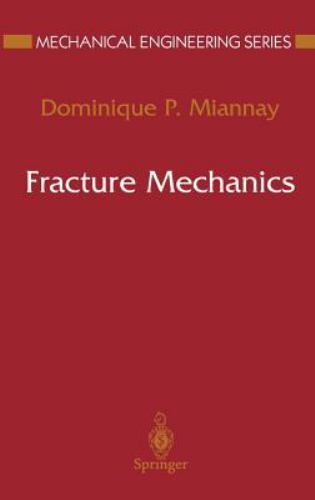Picture 1 of 1

Stock photo

Picture 1 of 1

Stock photo

Mechanical Engineering Ser.: Fracture Mechanics by Dominique P. Miannay (1997, Hardcover)

AlibrisBooks (461689)
98.6% positive feedback
Price:
US $135.64
ApproximatelyAU $209.51
+ $38.42 postage
Returns:
30-day returns. Buyer pays for return postage. If you use an eBay postage label, it will be deducted from your refund amount.
Condition:
New Hard cover
Oops! Looks like we're having trouble connecting to our server.
Refresh your browser window to try again.
About this product
Product Identifiers
PublisherSpringer New York
ISBN-100387982426
ISBN-139780387982427
eBay Product ID (ePID)729178
Product Key Features
Number of PagesXviii, 338 Pages
Publication NameFracture Mechanics
LanguageEnglish
SubjectMaterials Science / General, Fracture Mechanics
Publication Year1997
TypeTextbook
AuthorDominique P. Miannay
Subject AreaTechnology & Engineering
SeriesMechanical Engineering Ser.
FormatHardcover
Dimensions
Item Height0.4 in
Item Weight53.6 Oz
Item Length9.3 in
Item Width6.1 in
Additional Product Features
Intended AudienceScholarly & Professional
LCCN97-010651
Number of Volumes1 vol.
IllustratedYes
Dewey Decimal620.11
Table Of Content1 Microscopic aspects of fracture: Cohesive stress.- 2 Linear elastic behaviour of flaws: Purely elastic treatment.- 2.1 The notch: stress and strain concentrations.- 2.2 The crack: stress intensity factors.- 2.3 The three-dimensional crack.- 3 Linear elastic treatment of flaws: Plasticity correction.- 3.1 Model of small scale yielding for a notch.- 3.2 Models of small scale yielding for a crack.- 3.3 Implications of these models in fracture.- 4 Linear elastic treatment of fracture: The risk of brittle fracture.- 4.1 The toughness.- 4.2 The flaw.- 4.3 The mechanical loading.- 4.4 Example of application: Pressure vessels.- 5 Microscopic aspect of fracture: Cleavage and ductile rupture.- 5.1 Background of Dislocation Theory.- 5.2 Experimental modes of investigation.- 5.3 Cleavage fracture.- 5.4 Intergranular fracture.- 5.5 Ductile fracture.- 5.6 Shear fracture.- 5.7 The ductile-brittle transition with smooth and notched specimens.- 6 Plastic treatment of discontinuities: Fully plastic treatment and large deformation correction.- 6.1 Rigid-perfectly plastic material: The limit load.- 6.2 Strain hardening plastic material: The contour integral.- 6.3 The three-dimensional problem.- 6.4 Crack extension.- 6.5 Using the J integral in fatigue analysis.- 7 Plastic treatment of discontinuities: Elastic-plastic treatment.- 7.1 General description of stress and strain fields.- 7.2 The small-scale yielding and theQfamily of fields.- 7.3 Small Scale Yielding and mixed modes.- 7.4 Finite-width crack bodies.- 7.5 The loading parameters.- 7.6 The three-dimensional problem.- 7.7 The quasi-static growth.- 7.8 Implication of these models for fracture.- 8 Elastoplastic treatment of discontinuities: The risk of fracture.- 8.1 Toughness: Relationship between microscopic and macroscopic aspects.- 8.2 Structural applications.- Appendices.- Guide for Further Reading and Bibliography.- Answers to Selected Problems.
SynopsisIntended for engineers from a variety of disciplies that deal with structural materials, this text describes the current state of knowledge of how fractures in materials form and propagate, leading to failure., Intended for engineers from a variety of disciplines that deal with structural materials, this text describes the current state of knowledge of how fractures in materials form and propagate, leading to failure. The book begins by describing the fracture process at the two extremes of scale: first in the context of atomic structures, then in terms of a continuous elastic medium. Treating the fracture process in increasingly sophisticated ways, the book then considers plastic corrections and the procedures for measuring the toughness of materials. Practical considerations are then discussed, including crack propagation, geometry dependence, flaw density, mechanisms of failure by cleavage, the ductile-brittle transition, and continuum damage mechanics. The text concludes with discussions of generalized plasticity and the link between the microscopic and macroscopic aspects. The text is suitable for advanced undergraduates. Problems are provided at the end of each chapter.
LC Classification NumberTA418.5-.84





















